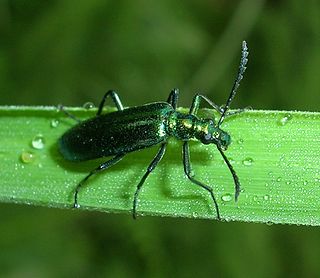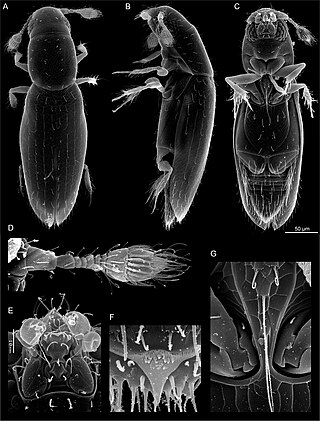
Beetles are insects that form the order Coleoptera, in the superorder Endopterygota. Their front pair of wings are hardened into wing-cases, elytra, distinguishing them from most other insects. The Coleoptera, with about 400,000 described species, is the largest of all orders, constituting almost 40% of described insects and 25% of all known animal species; new species are discovered frequently, with estimates suggesting that there are between 0.9 and 2.1 million total species. Found in almost every habitat except the sea and the polar regions, they interact with their ecosystems in several ways: beetles often feed on plants and fungi, break down animal and plant debris, and eat other invertebrates. Some species are serious agricultural pests, such as the Colorado potato beetle, while others such as Coccinellidae eat aphids, scale insects, thrips, and other plant-sucking insects that damage crops.

Staphylinoidea is a superfamily of beetles. It is a very large and diverse group with worldwide distribution.

Ptiliidae is a family of very tiny beetles with a cosmopolitan distribution. They are colloquially called featherwing beetles, because the hindwings are narrow and feathery.

Ptiliinae is the largest subfamily of feather-winged beetles. About 80% of the described genera of these very tiny beetles are contained herein; however, many more genera and species await description.

Prionoceridae is a small family of beetles, in the suborder Polyphaga. They form a group within the cleroid beetles and were formerly treated as a subfamily (Prionocerinae) within the family Melyridae. Very little is known of their life history but most species are pollen feeders as adults and occur in large numbers during spring or the host flowering season. Larvae are predatory or feed on decomposing wood.

Scydosella is a genus of beetles that consists of only one species Scydosella musawasensis. The species is regarded as the smallest free-living insect, as well as the smallest beetle. They are among featherwing beetle, named because of their feather-like spiny wings. It was first discovered in Nicaragua, and described in 1999 by Wesley Eugene Hall of the University of Nebraska State Museum. The initial discovery consisted of very few specimens, and exact measurements were not conclusive. Because of their tiny size, they were difficult to observe under microscope after preservation. The generally accepted size was 0.300 mm in length. On 8 February 2015, Alexey Polilov of the Lomonosov Moscow State University collected 85 specimens in Chicaque National Park, Colombia. They were discovered on a layer of fungus on which they feed. From these specimens exact measurements could be made, and was found that the smallest individual is only 0.325 mm long. The largest individual is 0.352 mm long, and the average length of all the specimens is 0.338 mm. The body is elongated and oval in shape, yellowish-brown in colour, and its antennae are split into 10 segments.
Discheramocephalus brucei is a species of feather-winged beetle, the smallest beetles on earth, first found in Cameroon.
Discheramocephalus elisabethae is a species of feather-winged beetle, the smallest beetles on earth, first found in Cameroon.
Discheramocephalus mikaeli is a species of feather-winged beetle, the smallest beetles on earth, first found in Tanzania.
Discheramocephalus stewarti is a species of feather-winged beetle, the smallest beetles on earth, first found in Bolivia.
Discheramocephalus jarmilae is a species of feather-winged beetle, the smallest beetles on earth, first found in Bolivia.
Discheramocephalus minutissimus is a species of feather-winged beetle, the smallest beetles on earth, first found in Indonesia. This species' adults have a body length of approximately 400 to 426µm. According to Grebennikov, the main factor limiting miniaturisation of female insects is an egg size significant enough in size to produce viable larvae. This size threshold is sometimes overcome, reaching limits of 180 and 130 µm in females and males, respectively, according to the author. Brain size is possibly the second most important factor limiting miniaturisation in this class.

The Spilopyrinae are a small subfamily of the leaf beetles, or Chrysomelidae. They occur in Australia, New Guinea, New Caledonia and Chile. They were formerly considered a tribe of the subfamily Eumolpinae. The group was elevated to subfamily rank by C. A. M. Reid in 2000. However, some authors have criticised this placement, preferring to retain them within the Eumolpinae.

Cartwrightia is a genus of scarab found in Latin America. It was named and circumscribed in 1958 by Federico Islas Salas. As of 2017, three species are recognized: C. intertribalis, C. cartwrighti, and C. islasi. They can be found in the nests of leafcutter ants or in dung.

Eumolpini is a tribe of leaf beetles in the subfamily Eumolpinae. It is the largest tribe in the subfamily, with approximately 170 genera found worldwide. Members of the tribe almost always have a longitudinal median groove on the pygidium, which possibly helps to keep the elytra locked at rest. They also generally have a subglabrous body, as well as appendiculate pretarsal claws.
Aphilenia is a genus of leaf beetles in the subfamily Eumolpinae. It is distributed in Central and East Asia as well as southern Russia. Members of the genus are adapted to dry climates, and feed on bushes of the genus Calligonum. In 2012, the genus was moved from the tribe Bromiini to the tribe Nodinini.
Discheramocephalus semisulcatus is a species of feather-winged beetle, the smallest beetles on earth.

Discheramocephalini is a tribe of feather-winged beetles first proposed in 2009. It contains six extant genera, and one extinct genus.
2017 in paleoentomology is a list of new fossil insect taxa that were described during the year 2017, as well as other significant discoveries and events related to paleoentomology that were scheduled to occur during the year.
Burmese amber is fossil resin dating to the early Late Cretaceous Cenomanian age recovered from deposits in the Hukawng Valley of northern Myanmar. It is known for being one of the most diverse Cretaceous age amber paleobiotas, containing rich arthropod fossils, along with uncommon vertebrate fossils and even rare marine inclusions. A mostly complete list of all taxa described up until 2018 can be found in Ross 2018; its supplement Ross 2019b covers most of 2019.









